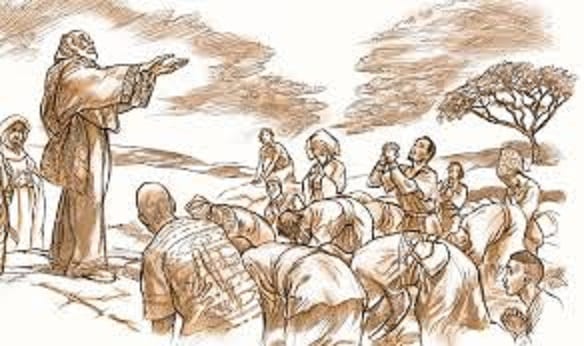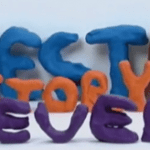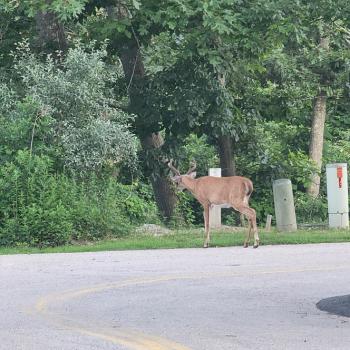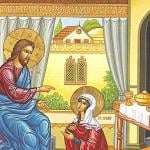My friend Mitch, who is the priest-in-charge at the Episcopal church I attend, has asked me provide a short reflection this morning as Trinity Episcopal does “virtual church” on Facebook Live for the second consecutive week. Here’s what I’ll say:
In the early days of Christianity, the desert monks had a saying, a divine directive that explained their calling: Fuge, Pace, et Quiesce. Loosely translated: Step back. Be quiet. And be at peace. It strikes me that this is a good directive for us as well. “Fuge” literally means to “flee,” but served as the call for the “social distancing” necessary for the solitary monastic life. “Quiesce” calls for silence and solitude, and “Pace,” peace, is perhaps the fruit of the spirit that is most essential in the brave new world in which we find ourselves. I’d like to talk for a few moments about peace.
My father, a Baptist minister who was a bit of a rock star in his specific niche of Christianity during my youth, frequently closed his final sermon in a week’s series at a Bible conference with Aaron’s blessing from the book of Numbers in the Hebrew scriptures.

The Lord bless you and keep you.
The Lord make his face to shine upon you, and be gracious unto you.
The Lord lift up his countenance upon you, and give you peace.
My father was one of the least naturally peaceful human beings I have ever met, but his favorite blessings from the Bible all involved the divine invocation of peace—I’ll give you another one at the end of my remarks.
The three synoptic gospels—Matthew, Mark, and Luke—include a story that greatly amused me when I was a child. After a demanding and exhausting day of teaching and healing people, Jesus is crossing the sea of Galilee at night in a boat with his disciples, many of whom were fishermen by trade. A storm blows in; the ship starts taking on water and begins to sink. Jesus is asleep in the rear of the boat with his head on a pillow, oblivious to the danger. The disciples wake him up in a panic: “Master, don’t you care that we perish?” Contemporary translation: “Jesus! Dude! We’re drowning here? What the hell??”
As a child, I imagined the newly awakened and still groggy from sleep Jesus sighing, rolling his eyes, and saying the magic words. “Peace, be still.” Immediately everything is calm and Jesus, slightly annoyed, says to his companions “Oh you of little faith, why are you afraid?” Then, I suspect, he returned to the rear of the boat and falls back to sleep. The disciples, talking among themselves, understandably say “Who is this guy? Even the wind and sea obey him.”
A few days ago, Jeanne and I were listening to Graham Cooke, a minister that she enjoys and introduced me to some time ago, in a Facebook Live event; his topic was peace in times of chaos and trouble. His reflection on the story of Jesus calming the storm included some insights that are directly relevant to the disruption, change, and unpredictability that are currently central to our daily lives. While asleep in the back of the boat, Jesus was providing his companions with the opportunity to practice peace, an invitation to make the presence of God tangible in the midst of chaos.
Every panic-stricken environment is a practice ground for peace. Peace involves a quiet state of mind. Viewing ourselves from a perspective of rest and confidence. Freedom from disturbance. Recognizing and believing that by simply entering a troubled situation you bring divine peace with you. Peace, as Graham Cooke says, can overwhelm an atmosphere of panic. Each of us, as individuals bringing God into the world through our daily lives, can seek out ways to “be peace” in our chaotic world.
For example, every time I teach a class on Zoom, as I look at anywhere from seven to thirty-two faces arranged in a grid on my computer screen, I am reminded that any number of these students may be living lives infected with panic and disturbance. They may be afraid. I can bring peace into their lives, not so much by what I say, but by simply remembering that this is yet another practice ground for me to “be peace” for others—to calm some storms that I may not even be aware of. Just before I enter the virtual classroom, I say aloud the verses from Psalm 131 that, while on sabbatical more than ten years ago, jumped off the page as I read them with dozens of Benedictine monks at noon prayer. They have become a centering mantra for me.
Surely, I have set my soul in silence and in peace. As a weaned child at its mother’s breast, so is my soul.
It even works virtually and at a distance.
The disciples, of course, failed miserably at bringing peace into their storm. They interpreted Jesus’ slumber as indicating that he didn’t care. Instead, after calming the storm, he reminded them that they already had within them what they thought they needed him for. “Why would you doubt, when all you need is a little faith?” he asked. Not faith in something separate from us, but faith in our empowerment to bring divine peace into the world just by being who we are. As Graham Cooke concluded, “That’s Jesus—happy to be with us, happy to give us opportunities to practice, happy to comfort us when we fail and ask us what we learned.” So, let’s practice “being peace” this week, even as we continue to physically distance and secure ourselves at home. Peace is not hindered by time or space.
I close with my father’s other “go to” benediction and blessing, this one from the end of his favorite New Testament book—the book of Hebrews:
Now may the God of peace, who raised from the dead our Lord Jesus, that great Shepherd of the sheep, through the blood of the everlasting covenant, make you perfect in every good work to do His will, working in you what is well-pleasing in His sight.
Remember the desert monks. Step back. Be quiet. And above all, be at peace.













